Are Scorpions Dangerous? Eight Things You Should Know
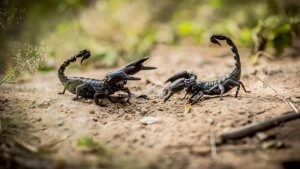

Written and verified by biochemistry Luz Eduviges Thomas-Romero
Commonly, when people write about scorpions they mainly focus on how dangerous they are. Unfortunately, they only promote the myth of how terrifying these creatures are. Enough is enough. The bad reputation attributed to scorpions is undeserved.
So, in today’s article, we’d like to help put an end to this universal phobia. We’ll do so by telling you a few, little known, facts about these beautiful creatures. You’ll get to know how incredible they are, and what amazing abilities they have. Yes, to know them is to love them.
1. Are scorpions dangerous because they’re venomous?
Firstly, scorpions are arthropods that belong to the Arachnida class. This includes spiders, ticks, and mites. You can identify them because they all have a body with two sections and eight legs —their grasping pedipalps.
All scorpions produce venom. The scary-looking narrow tail is made up of five segments beginning at the abdomen and curved upwards. The final segment is an ovipositor and it’s where the production of venom takes place. This stinger has a sharp needle-shaped structure called aculeus, which serves to inoculate the venom into the scorpion’s prey.
A scorpion can control when it produces poison and how much it inoculates. It all depends on whether they need to kill prey or merely defend themselves from predators.
2. Scorpions aren’t too dangerous for people
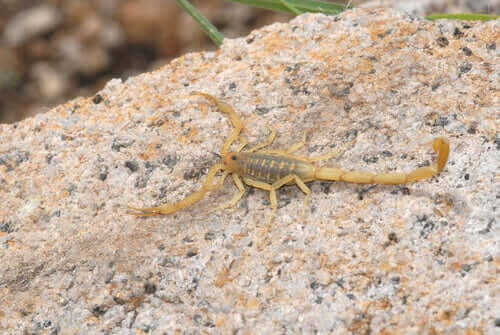
Young children and older people are at greater risk. The young ones because of their small size, and the old ones only if their immune system is weak. There’s only one scorpion worth worrying about here in the USA: the Arizona bark scorpion, Centruroides sculpturatus. It produces poison strong enough to kill a small creature.
Fortunately, antivenom is widely available in most medical facilities. For this reason, deaths by scorpion sting are rare.
3. They’re viviparous
Unlike insects, which generally lay eggs outside their bodies, scorpions produce offspring that’s fully formed, which means they’re viviparous. Their gestational stage can be as short as two months, or up to 18 months, depending on the species. After birth, newborn scorpions ride on their mother’s back, where they remain protected until they begin to move on their own.
4. Scorpions are one of the oldest creatures on the planet
Scientists believe that current specimens evolved from large creatures, about 3 feet long, that emerged from the sea. There’s fossil evidence that may suggest this.
Apparently, the first ancestors of the scorpion lived in the seas. In the Silurian period, 420 million years ago, some of these creatures adapted to life outside the water.
5. Scorpions can survive almost anything
So, now that you know how old scorpions are, you can probably imagine how surprisingly resilient they are. Even though they usually live for up to two to three years, some of them can live up to 25 years. Scorpions are real survival champions.
For example, a scorpion can live a whole year without eating or drinking anything. This is because they can slow down their metabolism when food is scarce. Because they have book lungs, they can remain underwater for several hours without drowning.
Scorpions are used to living in harsh and dry environments. They have extremely low metabolic rates and require only one-tenth of the oxygen that most insects do. Scorpions even have a high resistance to the effects of radioactivity. Of course, it makes their chances of surviving a nuclear attack much higher than the rest of the animal species.
Scorpions are the kings of adaptation. It’s no coincidence that there are scorpions in nearly every continent of the planet. Antarctica is the exception.
6. They eat almost everything they can get
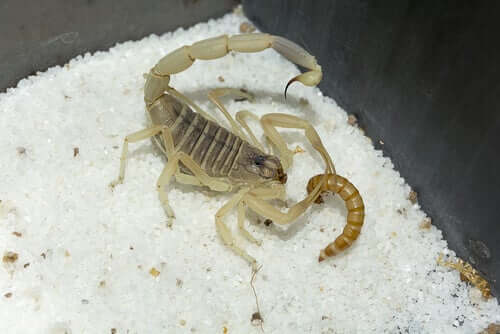
Most scorpions are night hunters and they feed on insects, spiders, and smaller arthropods. Also, some feast on larvae and earthworms.
Larger scorpions can eat larger prey. Actually, some even eat small rodents and lizards. While many of them feed on anything that’s edible, others have a specific preference for certain families of beetles and digging spiders. In fact, a hungry mother will eat her own babies if resources are scarce.
7. Are scorpions dangerous because they glow in the dark?
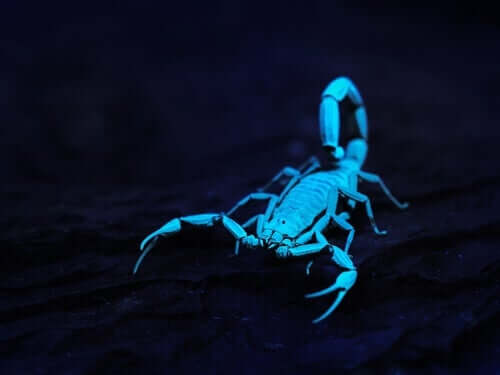
For unknown reasons, scorpions glow under ultraviolet light. That is, the cuticle or skin of the scorpion absorbs ultraviolet light and reflects it as visible light to the human eye.
This feature was helpful to identify many new scorpion species. This is because scorpion fossils still emit fluorescence, despite having spent hundreds of millions of years embedded in rocks.
8. Scorpions dance before mating
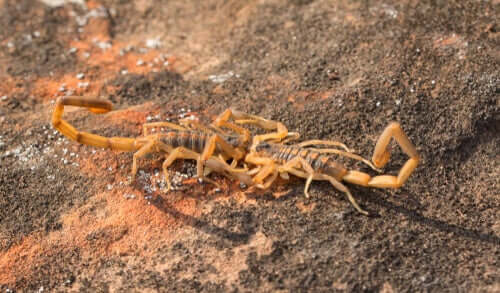
Scorpions participate in an elaborate courtship ritual, which includes a sort of dance. It begins when the male and the female make initial contact. Then, during the dance, the male finds a suitable place for his spermatophore.
Once the male scorpion deposits his sperm pack, he proceeds to guide the female over it. Then he places her genital opening there so she can collect the sperm. In their natural habitat, the male will make a quick exit once the mating is over. But, in captivity, the female will undoubtedly devour her partner.
As you can see, there’s nothing to fear. Scorpions reserve their venom for their prey and we’re just too large. When they do sting a human it’s all due to an unfortunate misunderstanding. Being in the wrong place at the wrong time.
Commonly, when people write about scorpions they mainly focus on how dangerous they are. Unfortunately, they only promote the myth of how terrifying these creatures are. Enough is enough. The bad reputation attributed to scorpions is undeserved.
So, in today’s article, we’d like to help put an end to this universal phobia. We’ll do so by telling you a few, little known, facts about these beautiful creatures. You’ll get to know how incredible they are, and what amazing abilities they have. Yes, to know them is to love them.
1. Are scorpions dangerous because they’re venomous?
Firstly, scorpions are arthropods that belong to the Arachnida class. This includes spiders, ticks, and mites. You can identify them because they all have a body with two sections and eight legs —their grasping pedipalps.
All scorpions produce venom. The scary-looking narrow tail is made up of five segments beginning at the abdomen and curved upwards. The final segment is an ovipositor and it’s where the production of venom takes place. This stinger has a sharp needle-shaped structure called aculeus, which serves to inoculate the venom into the scorpion’s prey.
A scorpion can control when it produces poison and how much it inoculates. It all depends on whether they need to kill prey or merely defend themselves from predators.
2. Scorpions aren’t too dangerous for people

Young children and older people are at greater risk. The young ones because of their small size, and the old ones only if their immune system is weak. There’s only one scorpion worth worrying about here in the USA: the Arizona bark scorpion, Centruroides sculpturatus. It produces poison strong enough to kill a small creature.
Fortunately, antivenom is widely available in most medical facilities. For this reason, deaths by scorpion sting are rare.
3. They’re viviparous
Unlike insects, which generally lay eggs outside their bodies, scorpions produce offspring that’s fully formed, which means they’re viviparous. Their gestational stage can be as short as two months, or up to 18 months, depending on the species. After birth, newborn scorpions ride on their mother’s back, where they remain protected until they begin to move on their own.
4. Scorpions are one of the oldest creatures on the planet
Scientists believe that current specimens evolved from large creatures, about 3 feet long, that emerged from the sea. There’s fossil evidence that may suggest this.
Apparently, the first ancestors of the scorpion lived in the seas. In the Silurian period, 420 million years ago, some of these creatures adapted to life outside the water.
5. Scorpions can survive almost anything
So, now that you know how old scorpions are, you can probably imagine how surprisingly resilient they are. Even though they usually live for up to two to three years, some of them can live up to 25 years. Scorpions are real survival champions.
For example, a scorpion can live a whole year without eating or drinking anything. This is because they can slow down their metabolism when food is scarce. Because they have book lungs, they can remain underwater for several hours without drowning.
Scorpions are used to living in harsh and dry environments. They have extremely low metabolic rates and require only one-tenth of the oxygen that most insects do. Scorpions even have a high resistance to the effects of radioactivity. Of course, it makes their chances of surviving a nuclear attack much higher than the rest of the animal species.
Scorpions are the kings of adaptation. It’s no coincidence that there are scorpions in nearly every continent of the planet. Antarctica is the exception.
6. They eat almost everything they can get

Most scorpions are night hunters and they feed on insects, spiders, and smaller arthropods. Also, some feast on larvae and earthworms.
Larger scorpions can eat larger prey. Actually, some even eat small rodents and lizards. While many of them feed on anything that’s edible, others have a specific preference for certain families of beetles and digging spiders. In fact, a hungry mother will eat her own babies if resources are scarce.
7. Are scorpions dangerous because they glow in the dark?

For unknown reasons, scorpions glow under ultraviolet light. That is, the cuticle or skin of the scorpion absorbs ultraviolet light and reflects it as visible light to the human eye.
This feature was helpful to identify many new scorpion species. This is because scorpion fossils still emit fluorescence, despite having spent hundreds of millions of years embedded in rocks.
8. Scorpions dance before mating

Scorpions participate in an elaborate courtship ritual, which includes a sort of dance. It begins when the male and the female make initial contact. Then, during the dance, the male finds a suitable place for his spermatophore.
Once the male scorpion deposits his sperm pack, he proceeds to guide the female over it. Then he places her genital opening there so she can collect the sperm. In their natural habitat, the male will make a quick exit once the mating is over. But, in captivity, the female will undoubtedly devour her partner.
As you can see, there’s nothing to fear. Scorpions reserve their venom for their prey and we’re just too large. When they do sting a human it’s all due to an unfortunate misunderstanding. Being in the wrong place at the wrong time.
All cited sources were thoroughly reviewed by our team to ensure their quality, reliability, currency, and validity. The bibliography of this article was considered reliable and of academic or scientific accuracy.
- Santillan, E. G. (2004). Diversidad, taxonomía y habitat de alacranes. Artrópodos de Chamela, 25-35.
- Castilla, A. M., & Pons, G. X. (2007). Primeros datos sobre la población de escorpiones (Buthus occitanus) en las Islas Columbretes (Mediterráneo, España). Bolletí de la Societat d’Història Natural de les Balears, 50, 257-268.
- Abolafia, J., Arbea, J. I., Garcia, L., Hernando, C., López-Rodríguez, M. J., Mauriès, J. P., … & Subías, L. S. (2016). Invertebrados de interés en cuevas y simas de la Sierra de Segura (Jaén, Andalucía, España). Actas Espeleo Meeting Ciudad de Villacarrillo, 105, 111.
- Ortuño, V. M., & Martínez-Pérez, F. D. (2011). Diversidad de artrópodos en España. Memorias de la Real Sociedad Española Historia Natural, 2(9), 235-284.
This text is provided for informational purposes only and does not replace consultation with a professional. If in doubt, consult your specialist.








